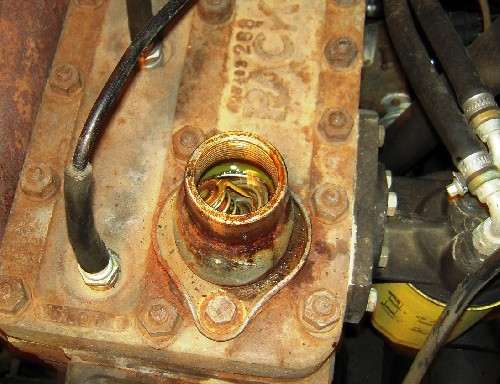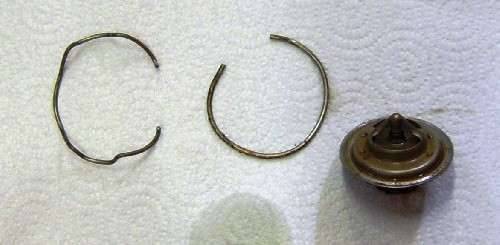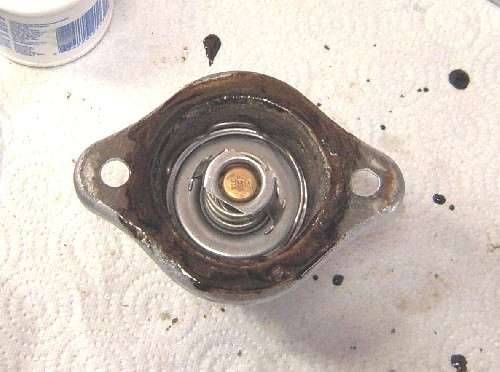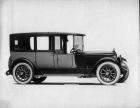|
Re: wiring questions
|
||||
|---|---|---|---|---|
|
Just can't stay away

|
A GREAT explanation, BigKev. Thank-you.
Jim G
Posted on: 2008/9/4 17:51
|
|||
|
||||
|
Re: wiring questions
|
||||
|---|---|---|---|---|
|
Just can't stay away

|
BigKev:
1. So, if I want to use a conventional ignition switch (with "Start" position) in place of the Packard ignition switch, I just bypass the carb switch, right? 2. What does the dashboard "battery light" do when you are running an alternator? When does it come on? I notice you have it wired to the "accessory" position. Jim G
Posted on: 2008/9/3 21:25
|
|||
|
||||
|
Re: Thermostat & retainer - can this REALLY be CORRECT??
|
||||
|---|---|---|---|---|
|
Just can't stay away

|
Thank you both, BUT that $60 price was last refreshed, accoridng to the little note on website maintenance, in 2002! I suspect it costs more right now.
I have sent an email to the folks there, as there are no provisions for telephone contact at all. I've asked them how I can buy both the cast housing and the matching retainer (advertised on the same page, as I strongly suspect that retainer is DIFFERENT than the normal Packard one, as the part number is unique. Jim G
Posted on: 2008/8/30 11:27
|
|||
|
||||
|
Re: Thermostat & retainer - can this REALLY be CORRECT??
|
||||
|---|---|---|---|---|
|
Just can't stay away

|
My nubs must have worn or rusted off over the years, I guess.
1. Where do I get a new reproduction or NOS thermostat housing? 2. I assume I will again need a new gasket, even if I do the replacement of the housing within a few days of installing today's new gasket? 3. I suppose that now there is a good possiblity that the darn thermostat will again fall out of position in the meantime. Any chance that the retainer ring could actually fall into the engine, or is that impossible? Should I disassemble again, remove the thermostat and retainer entirely, and run no thermostat until the new housing and gasket can be obtained? Its 95 to 100 degrees here right now virtually every day, so the thermostst should be wide open anyway vritually all the time except on startups. Jim G
Posted on: 2008/8/29 21:17
|
|||
|
||||
|
Re: Thermostat & retainer - can this REALLY be CORRECT??
|
||||
|---|---|---|---|---|
|
Just can't stay away

|
BigKev: My themrostat housing:
(a) has NO nubs (b) is entirely different in shape than yours, AND the base on mine is formed stamped metal,no cast like on yours. How can this be???? My Packard is a 1952 200 Deluxe with 288 cubic inch 135 hp engine. Jim G
Posted on: 2008/8/29 20:15
|
|||
|
||||
|
Thermostat & retainer - can this REALLY be CORRECT??
|
||||
|---|---|---|---|---|
|
Just can't stay away

|
This posting is all about how a "simple" task can be anything BUT simple, and it ends with an important question which I hope the more experienced "men ( or women) who own one" can answer.
I knew there was something wrong with my old thermostat: My friend Randy had pointed out to me that IMMEDIATELY upon engine startup after we installed the new hi-performance radiator, he looked into the radiator (before the cap was put on) and saw coolant being CIRCULATED. This of course should not have happened with a dead cold engine. The engine thermostat should have kept the coolant in the engine block until the coolant got hot enough to open the thermostat. So, I order a new thermostat ("normal" temperature setting: 160 degrees) from Max Merrit, along with a new thermostat housing gasket, and a new "retainer". Packards require a retainer to hold the thermostat in position in the thermostat housing. Without the retainer, the thermostat will simply fdall right into the cylinder head. I asked about how that retainer is properly installed, right here on the forum, and was told it would be"obvious". Not so. This "simple" thermostat replacement took me over 2 hours this morning, and it was comical I'm sure for the two donkeys who watched me do it. The first step is to drain sufficient coolant from the system to get the level low enough to prevent a flood when you break the seal on the thermostat housing. There was a "surprise" right at this stage. I took off the radiator cap, and then unscrewed and removed the radiator drain cap. This produced a "pisser" of a stream of coolant that extended a full 20" past the front of the radiator! (I gazed at this for 1 or 2 seconds in pure envy :) ). Fortunately, I had a 24" long drain pan pre-positioned, and it took me only seconds to get the guyser flowing INTO rather than PAST the tray! I noted with satisfaction that the coolant was still remarkably clean after a couple of hundered miles since the radiator swap, so maybe the interior of the engine is NOT all full of the dreaded "sludge" after 56 years. After draining enough to be sure that the level of coolant was below the upper hose, I got only a few ounces up my arm closing the darn drain. Next, I loosened the clamps on both ends of the upper radiator hose, and gently pried it off. When I looked into the now exposed hole in the thermostat housing, I found two more surprises: 1. That hole is inexplicably internally THREADED and 2. The old thermostat was actually there, but as you can see in the two photos of it below (taken from above when still installed, and then from below after the thermostst housing was removed), the thermostat was NOT properly secured, but was rather jammed in there at a cocked angle. With the position it was in, it would NEVER stop coolant flow through the radiator for engine warm-up, but on the other hand, it would also never allow "full flow", since it was blocking the passageway the coolant needed to take! After I rmeoved the two thermostat housing bolts, and looked inside the thermostat, I could see yet three more surprises: 1. The retainer ring used was NOT the correct Packard retainer ring, but rather a simple circular wire ring and 2. It had failed to hold the thermostat, and this is how the thermostat got cocked and jammed in that cocked position and 3. The thermostat was a 190 degree thermostat, versus the 160 degree thermostat that JD at Max Merritt had told me was the correct standard one. I cleaned the housing thoroughly, inside and out, and even repainted it bright silver using a real stove enamel spray. I figured I had now found all the surprises. I was wrong. When I tried putting the new thermostat in,it of course will fit from only the engine side of the housing (rad hose hole is much too small), so I KNOW I was putting it from the right end. I also know that the "ox yoke" shaped part goes on top, and the spring end faces the engine. There IS indeed a convenient ledge for the thermostat to "seat against" when placed into the housing this way. However . . . If you then turn the housing right side up, the thermostat of course just drops out. This is where the magical retainer comes in. Or should. HOW that complexly-shaped retainer is supposed to be mounted (which end up) is not at ALL "obvious", and it is also VERY far from obvious what keeps the retainer from simply sliding out of position itself over time. Take a look at the 3rd photo that shows this new funny shaped retainer on the left beside the incorrect circular one removed on the right. Would YOU know how to position it correctly?? Let's take these two problems one at a time. For "which side up", I did the only sensible thing: I tried both ways. One way held the thermostat only very loosely, allowing it to move a bit, and I knew that couldn't be right, so I turned the ring upside down. That seemed to hold the thermostat, at least without any vibration or thermal expansion and contraction occurring. But I have zippo confidence that the retainer would STAY in thew right position. Why? Because there is no groove or any other mechanism to seat the retainer!! Its security depends entirely upon a very SLIGHT spring pressure it exerts against that wet and slippery thermostat interior wall. I'm underimpressed with THAT. I'm thinking now: this CAN'T really be correct can it? CAN IT? Or, is the silly complex retainer supposed to somehow mount in some way that holds the thermostat in some convoluted fashion, where the retainer somehow gets anchored PAST the thermostat into that ledge that the thermostat seats against. Of course, the only way to do that IF it can be done, would break "the seal" between the engine side of the thermostat and the radiator side, thus allowing leakage ALL the time. So, that does not sound right. I looked hard for signs of any grooves or retaining slots. In the entire interior surface of that thermostat housing, there is only ONE recessed area, that is less than ?" x ?", and there is NO apparent way to get ANY portion or either end of the complex retaining ring into it. So, I'm now throwing up my hands in frustration and simply asking any Packard man or woman who knows what he or she is doing: 1. "How the heck is this supposed to assemble? And 2. If I did it wrong, do I now need to order yet again another new gasket to do the install again? Damn it, I bought this car for its SIMPLICITY. I've atatched a 4th photo that shows how I got it all to "fit", and it did road test apaprently ok, but I REALLY wonder if I have missed the proper assembly idea here. Jim G
Posted on: 2008/8/29 19:26
|
|||
|
||||
|
Re: "Special" items when converting to 12 volt?
|
||||
|---|---|---|---|---|
|
Just can't stay away

|
Does an air conditioning compressor clutch draw power:
1. ONLY when engaging or disengaging? or 2. All the time when engaged? I'm trying to figure out how LONG that 5 amps is required - brief bursts or continuous for minutes at a time? Jim G
Posted on: 2008/8/29 13:06
|
|||
|
||||
|
Re: "Special" items when converting to 12 volt?
|
||||
|---|---|---|---|---|
|
Just can't stay away

|
HH56: With a dual pulley groove arrangement like in the photo, are BOTH grooves being driven ONLY when the AC compressor clutch is engaged? or, does the dual pulley get driven all the time, and the clutch only disconnects or connects the compressor itself?
That is, when the compressor clutch is NOT engaging the compressor to run, is the alternator being driven by its belt or not? Not a big deal if it IS being driven all the time, but less efficient. Jim G
Posted on: 2008/8/28 14:09
|
|||
|
||||
|
Re: new to the group, need some advice/opinions
|
||||
|---|---|---|---|---|
|
Just can't stay away

|
See my "Not what you would expect" thread in the "Modifications" section. :)
Jim G
Posted on: 2008/8/28 13:14
|
|||
|
||||

 (39.10 KB)
(39.10 KB)










